Mastering Salmon Sushi: Techniques and Recipes
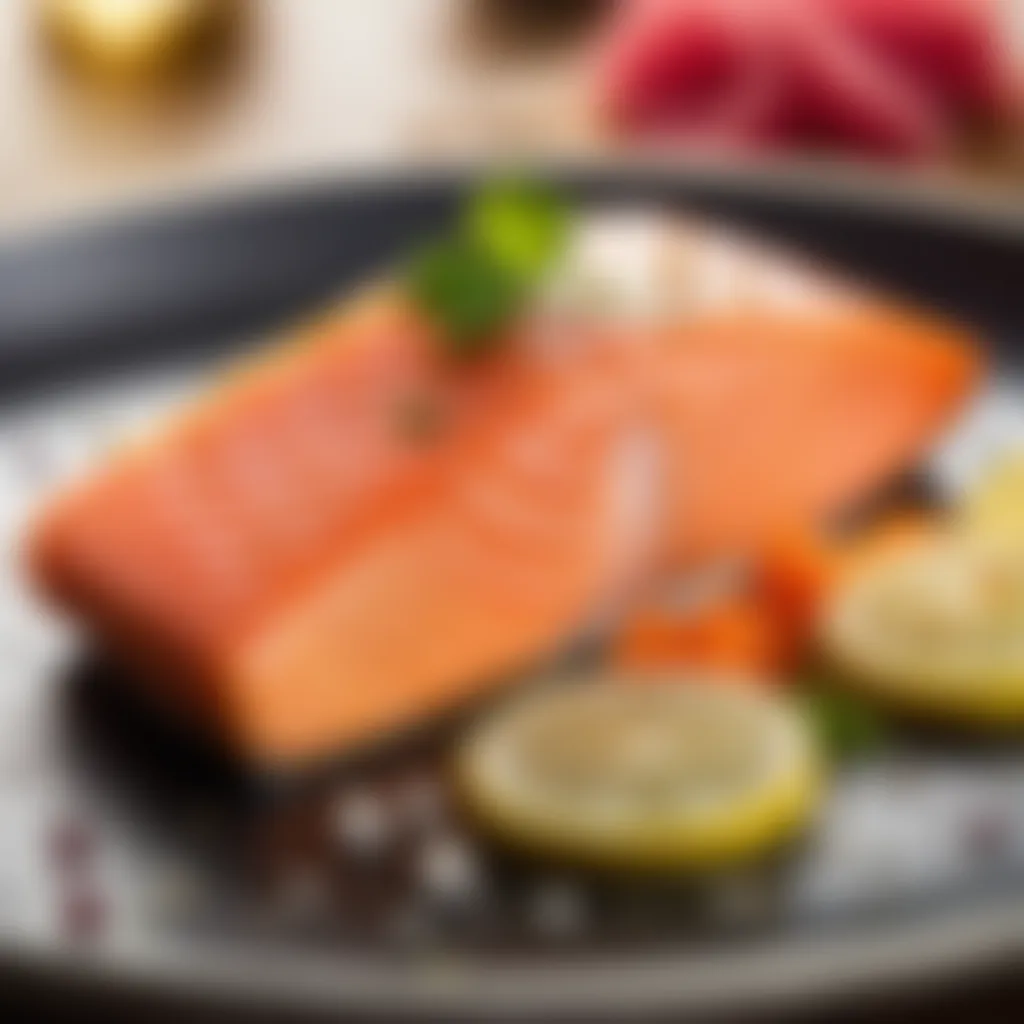

Intro
Crafting salmon sushi is an intricate dance between flavor and technique, where precision plays a pivotal role. For housewives looking to impress family or guests, mastering this culinary art can elevate any gathering. Salmon, with its luscious texture and rich flavor, stands as a favorite for many, providing a canvas for creativity and tradition alike.
Engaging in sushi preparation not only brings delectable results but also opens up a world of cultural appreciation. From selecting the finest ingredients to plating with flair, this guide seeks to walk you through every significant step. Let’s begin by immersing ourselves in what makes this dish so special by compiling a thorough list of ingredients.
Foreword to Salmon Sushi
Crafting salmon sushi is not just about the delicious result on your plate; it is a celebration of culture, tradition, and skills shared over generations. In this section, we will delve into what makes salmon sushi significant, exploring its definition and characteristics, as well as the rich cultural background that shapes it.
Definition and Characteristics
Salmon sushi is a type of sushi that primarily features salmon as its main ingredient. It can be enjoyed in various forms, such as nigiri, sashimi, or rolls. The defining characteristics of salmon sushi hinge on the quality of the fish, the texture of the rice, and the balance of flavors. Freshness is key; the salmon should have a vibrant color and a firm texture, while the rice needs to be seasoned properly with vinegar, sugar, and salt to achieve the right taste.
When made properly, salmon sushi offers a distinct umami experience that captures both the ocean's bounty and the intricacies of Japanese culinary techniques. The chill of the fish against the warm rice creates a delightful contrast, and the subtle seasoning enhances the natural flavors. Add a touch of wasabi or soy sauce, and you’ve got sensations that dance in your mouth.
Cultural Background
The roots of salmon sushi are intertwined with Japanese culinary history. Traditionally, sushi originated as a means of preserving fish using fermented rice in Southeast Asia. Over time, this method developed into the numerous sushi varieties we see today. The use of salmon is particularly interesting because it became popular in Japan only in the late 20th century, despite being native to the Pacific Northwest.
Salmon sushi has taken hold not just in Japan but globally, appealing to diverse palates. It embodies a blend of innovation and tradition, straddling ancient methods of preparation and modern tastes. This adaptability speaks to its wide appeal, allowing culinary artists in various kitchens to create their unique takes on this classic dish.
"To truly appreciate salmon sushi, one must understand the delicate balance between art and technique that goes into each piece."
In crafting salmon sushi, the realization sets in that it's about more than just eating. It becomes a culinary journey, filled with learning about local ingredients, sustainability, and the meticulous nature of Japanese cooking methods. For anyone passionate about culinary arts, knowing the ins and outs of salmon sushi can dramatically elevate your cooking game, making the whole process as enjoyable as the final product.
The Importance of Quality Ingredients
When it comes to crafting exquisite salmon sushi, the ingredients play a pivotal role. Quality allows for the full expression of flavors, textures, and colors that are quintessential to sushi. Without high-caliber ingredients, even the most skilled sushi chef might struggle to create a memorable dish. A sushi roll can be compared to a symphony; if one instrument is out of tune, the entire experience suffers.
Selecting Fresh Salmon
Choosing fresh salmon is not just about grabbing any fillet from the seafood aisle. What you want is salmon that sings of quality. Opt for wild-caught salmon, if possible. This fish, swimming freely in cold waters, tends to have better flavor and texture. When selecting your salmon, look for vibrant color — a bright reddish-pink hue is ideal. The flesh should appear moist, with a slight sheen.
Here are a few tips to ensure your salmon is top-notch:
- Smell Test: Fresh salmon should have a clean, ocean-like scent. If it’s off or has a strong fishy odor, steer clear.
- Texture Check: Press your finger into the flesh. It should spring back easily. If it leaves an indentation, the fish is past its prime.
- Source Information: Check for labels indicating sustainable fishing practices. Sustainable options aren’t just kind to the environment; they also tend to offer superior flavor.
The safety and quality of your salmon are paramount. A well-chosen fillet can make all the difference in your final dish.
Understanding Sushi Rice
Sushi rice often takes a backseat, but neglecting it can lead to a less-than-stellar sushi experience. The rice is more than just a filler; it’s the heart and soul of sushi. Nikiri, which is seasoned rice vinegar mixed with sugar and salt, is commonly used to enhance the flavors of plain rice. The key is in the starch: the right kind will give a slightly sticky texture, holding your sushi together without becoming mushy.
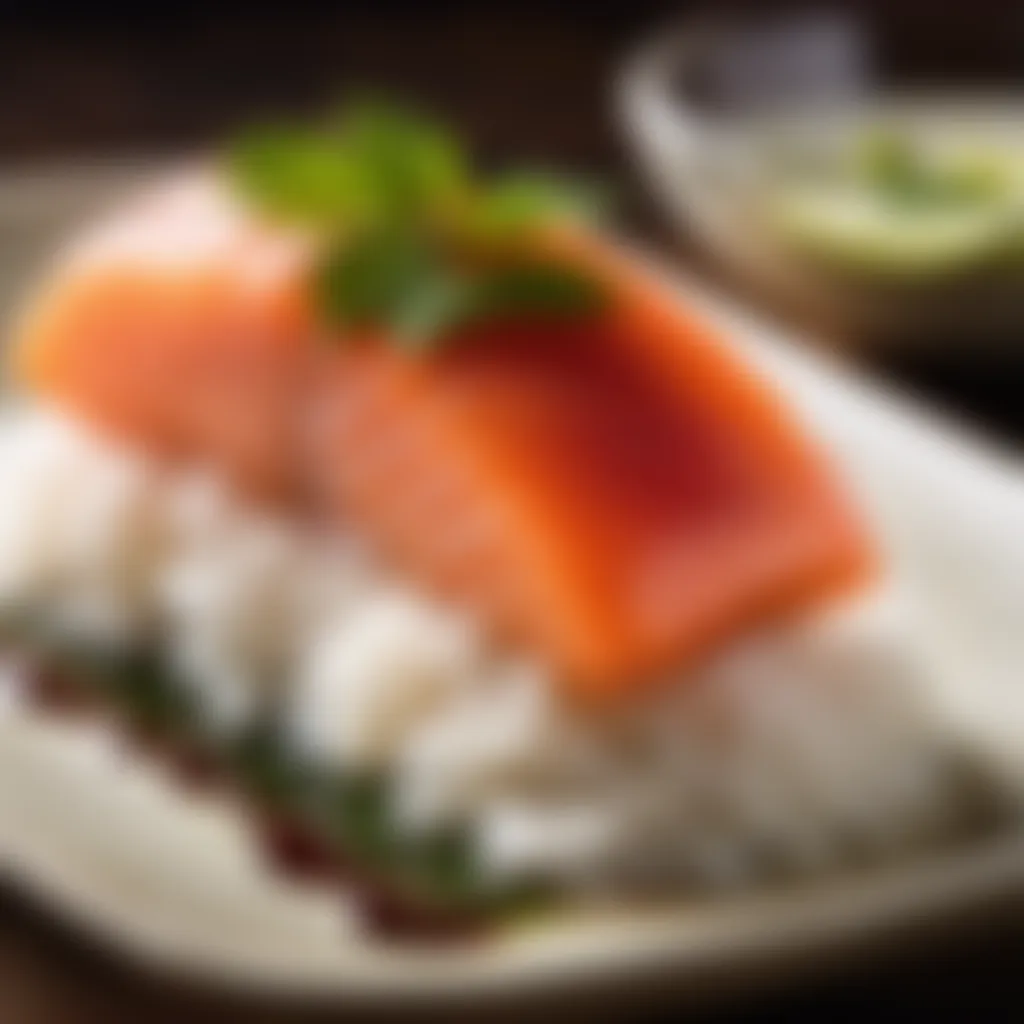
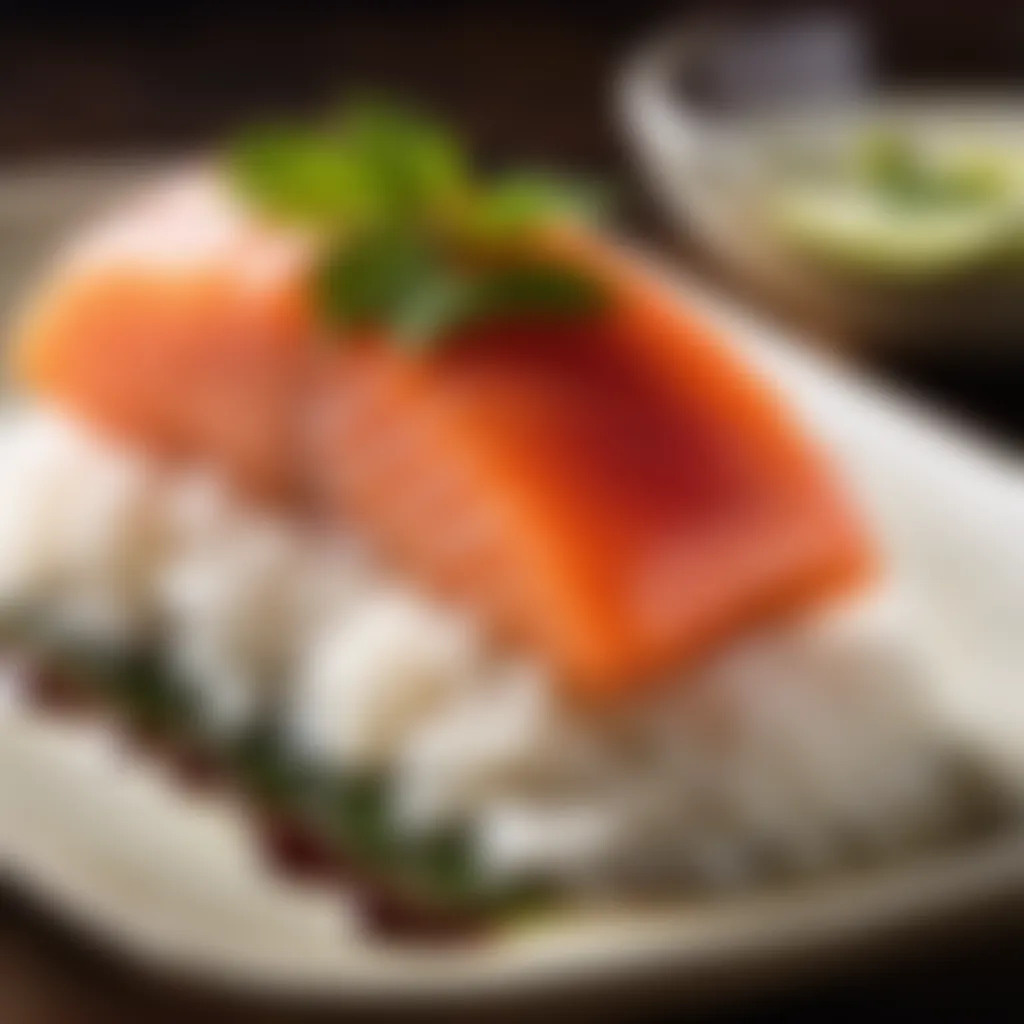
When preparing sushi rice, remember:
- Rinsing: Wash the rice until the water runs clear. This removes excess starch and helps prevent it from becoming overly sticky during cooking.
- Cooking: Use a rice cooker for the best results, or follow a traditional stove method that maintains precise water-rice ratios.
- Cooling: Once cooked, transferring the rice to a wooden or shallow container helps it cool evenly, allowing the flavors to mingle.
Lastly, the seasoning — balanced to perfection — enhances the rice, making it a star ingredient in its own right.
Other Essential Ingredients
Beyond salmon and rice, a rich tapestry of ingredients adds dimension to your sushi making.
- Seaweed: Nori sheets are typically what hold everything together in rolls but ensure they're crisp and free from any tears. A good Japanese nori has a deep green color and a rich umami flavor.
- Wasabi: Real wasabi, not the imitation often found in stores, adds a punch that complements the salmon beautifully. It’s about layering flavors.
- Soy Sauce: Go with a high-quality soy sauce to dip your sushi. It can enhance the taste and bring out hidden notes in your ingredients.
- Vegetables & Pickles: Add fresh cucumbers, avocados, and even pickled ginger for balance and freshness. Not only do they provide texture, but they also refresh the palate between bites.
Remember, each ingredient serves a purpose. They work together, just like a well-rehearsed team, to create that perfect sushi experience.
"Quality ingredients are the foundation for a sushi that dazzles the eyes and delights the palate."
Incorporating these exceptional ingredients without compromise will transform your sushi-making journey from ordinary to extraordinary.
Preparation Techniques
Preparation techniques form the backbone of crafting salmon sushi. They dictate not only the quality of the sushi itself but also the overall eating experience. The process that starts with selecting the right fish and rice translates into the delicate balance of flavors that defines sushi. Mastering these preparation techniques ensures that every step along the way is done with precision, which elevates the dish from mere food to an art form.
Before diving into the specific techniques, it’s crucial to understand that each component—salmon, rice, and accompaniments—needs to be treated with care and respect. This is not just about following a recipe; it's about creating a symphony of flavors and textures on a single platter. The right techniques can make a world of difference in taste, texture, and presentation.
Cleaning and Filleting Salmon
Keeping your salmon fresh and properly filleted is paramount in creating a good sushi dish. Start with a well-chosen piece of salmon, ideally sourced from a reputable supplier. Before you get your hands dirty, ensure your workspace and tools are clean. Here's how to approach the cleaning and filleting:
- Rinse the Salmon: Start by rinsing the salmon under cold water to remove any surface contaminants.
- Pat Dry: Use a clean cloth to pat the salmon dry. Moisture can affect the quality of your preparation.
- Remove Bones: Using tweezers, gently extract any pin bones from the fillet to avoid unpleasant surprises while eating.
- Filleting: Hold the fish tail, slice away from the bones at a 45-degree angle. Take your time here, as perfecting your slicing technique will ensure you have beautiful, clean pieces.
"A well-filleted salmon is key to the perfect sushi, allowing for ease of rolling and a better texture for the consumer."
Cooking Sushi Rice
The heart of any sushi dish lies in its rice. It must be cooked to perfection, sticky enough to hold its shape yet not mushy. A common mistake is overcooking the rice or failing to rinse it adequately. Follow this step-by-step guide:
- Measure Rice: Use a 1:1 ratio of sushi rice to water. This ensures the rice cooks evenly and turns out perfectly.
- Rinse Thoroughly: Rinse the rice several times until the water runs clear to remove excess starch. This eliminates any potentially unwanted stickiness.
- Cook the Rice: A rice cooker works wonders here. Set it and forget it! If you opt for a stovetop method, bring the water to a boil, then reduce the heat and cover until cooked.
- Season the Rice: Once the rice is cooked, let it cool slightly and fold in a mixture of rice vinegar, sugar, and salt. This mixture not only flavors the rice but also helps with its stickiness.
Preparing Accompaniments
Accompaniments are often the unsung heroes of sushi. They enhance the experience by balancing flavors and adding texture. Here are a few steps to get your accompaniments ready:
- Pickled Vegetables: Making pickled ginger or vegetables is simple and can be done days in advance. The acidity complements the richness of the salmon.
- Wasabi: While you can buy wasabi paste, you might prefer to make your own. Mix wasabi powder with a bit of water to create a paste. It offers not just heat but also a depth of flavor.
- Cilantro or other herbs: Fresh herbs strikingly elevate sushi. A bit of cilantro can add a nice touch.
By focusing on these preparation techniques, you set up the stage for crafting great salmon sushi. It all begins here; the way you clean the fish, prepare the rice, and set the stage with accompaniments will define the overall outcome and enjoyment of your delicious creation.

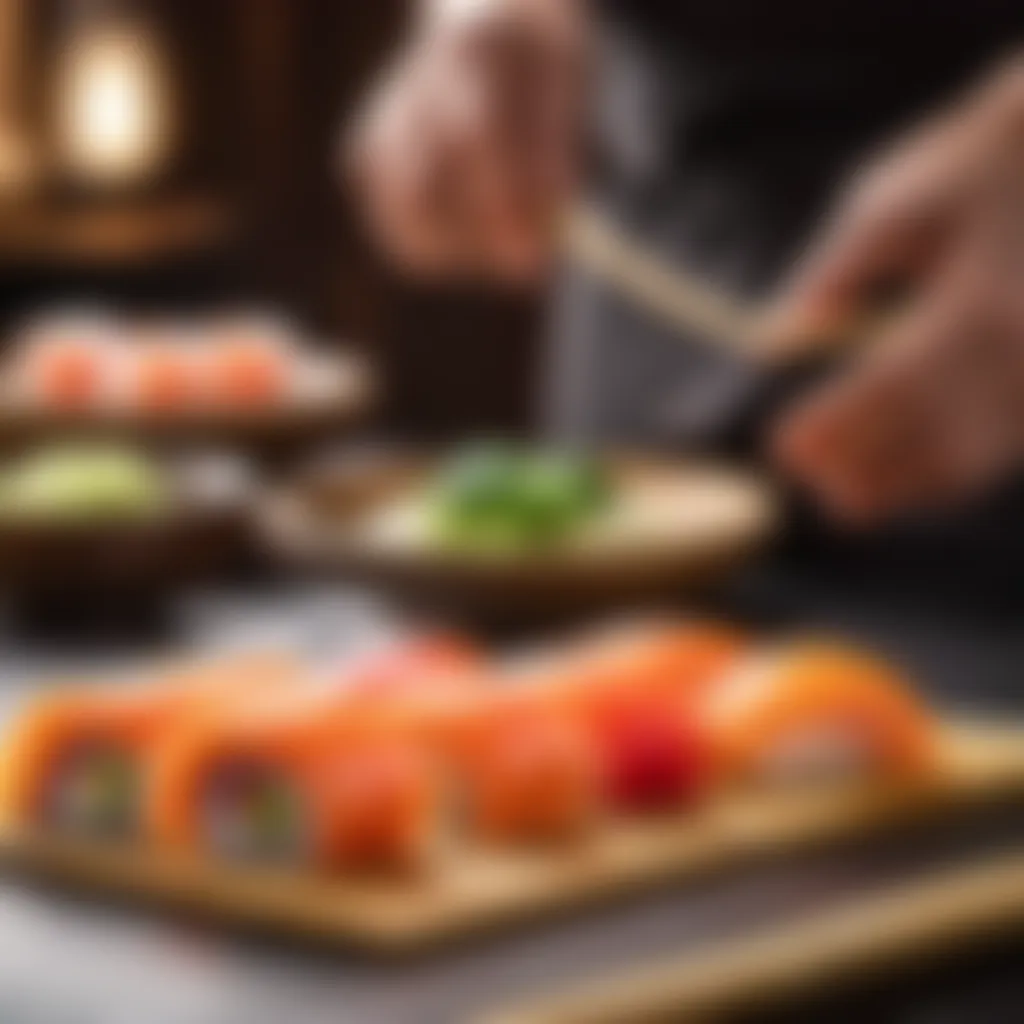
Sushi Making Techniques
Sushi making techniques are at the heart of crafting salmon sushi and understanding these techniques can substantially enhance the overall experience and presentation of your dish. From the rolling styles to the presentation of the sushi, each technique contributes to the aesthetic appeal and the flavor profile of the finished product. This article delves into the various sushi making techniques, providing insight into how each method can elevate your sushi experience.
Rolling Techniques
Uramaki
Uramaki, or inside-out rolls, are a unique way to create sushi that flips the traditional approach on its head. Instead of nori being on the outside, it's hidden under a layer of rice, making it a preferred choice for many. This specific aspect appeals to those who might find the taste of nori overwhelming since the rice provides a softer, more palatable flavor. It's popular for its ability to showcase colorful fillings like avocado and salmon, creating a visually stunning dish. Additionally, uramaki allows for a variety of sauces on top, such as mayonnaise or eel sauce, adding another layer of flavor. However, a pitfall could be that they can be tricky to roll, requiring a steady hand and practice to perfect the technique.
Temaki
Temaki, or hand rolls, are a fantastic option for those who enjoy a more interactive eating experience. This specific style allows for easy customization, letting each person choose their own ingredients. The sushi is rolled into a cone shape, which not only looks appealing but also makes it easy to hold. It’s a beneficial choice for gatherings, encouraging creativity and engagement amongst guests. A unique feature of temaki is how it allows for a generous filling of ingredients that traditional rolls may struggle with. That said, one downside is that they are best eaten immediately, as the nori can become soggy if set aside for too long.
Chirashi
Chirashi, or scattered sushi, takes a different approach by presenting all the ingredients neatly arranged over a bed of sushi rice. This style shines mainly in its simplicity and artistic presentation. Each component, from fresh salmon to colorful vegetables, can be showcased beautifully, making it a gallery of flavors on a plate. The key characteristic that makes chirashi popular is the flexibility it offers. You can switch up the ingredients based on what’s fresh or in season, which can enhance the experience of your sushi craft. However, a drawback might be that it lacks the tactile fun of rolling sushi, instead leaning into being a more relaxed dining experience.
Presentation Styles
Plate Arrangements
Plate arrangements play a crucial role in sushi making techniques, as they significantly impact how the dish is perceived. The way sushi is presented on a plate can make or break the dining experience. A well-arranged plate can enhance the aesthetic appeal, drawing attention to the vibrant colors of salmon and the glossy sheen of sushi rice. It also allows you to utilize garnishings effectively, heightening the look of the dish. The essence of good plate arrangements lies in balance and harmony—avoiding overcrowding while allowing each element to shine. However, the downside is that it may require a bit of practice to master the art of sushi plating.
Garnishing
Garnishing isn’t just an afterthought; it’s an essential technique that elevates the overall sushi dish. Sprigs of fresh herbs, sesame seeds, or even edible flowers can turn a simple plate of sushi into a feast for the eyes. This specific aspect of garnishing adds color and texture, enhancing the overall aesthetic appeal and making the sushi more inviting. A key benefit of garnishing is that it can also contribute to the flavors of the dish. Think about a dash of soy sauce or a sprinkle of wasabi. Yet, one must be cautious not to overpower the main ingredients, as the goal is to complement rather than overshadow the sushi itself.
"Presentation of food is akin to a first impression—it can set the mood for the entire dining experience."
Every sushi making technique, from rolling to garnishing, plays an instrumental role in the final outcome of your salmon sushi creation. Each method not only alters the form but also enhances the taste, making it important for any budding sushi enthusiast to explore and master.
Health Considerations
When it comes to crafting salmon sushi, understanding health considerations is crucial for ensuring not just the enjoyment of flavors but also the well-being of those indulging in this culinary art. Salmon, as a primary ingredient, offers numerous benefits, but it also requires proper handling and preparation to eliminate health risks. This section delves into the nuances of salmon's nutritional aspects and the safety guidelines essential for enjoying sushi safely.
Nutritional Aspects of Salmon
Salmon is often heralded as a superfood, and for good reason. Rich in omega-3 fatty acids, protein, and various vitamins, it bestows a host of health benefits. Here are some highlights:
- Omega-3 Fatty Acids: These are vital for heart health, aiding in reducing inflammation and lowering the risk of chronic diseases. They are also known for enhancing brain function and improving mood.
- High-Quality Protein: Protein is essential for building and repairing body tissues, and salmon provides a great source to meet daily requirements without excess saturated fat.
- Vitamins and Minerals: Salmon is loaded with essential vitamins like B12 and D, as well as selenium, which plays a key role in metabolism and thyroid function.
Incorporating salmon into one’s diet can contribute significantly to overall health, but how it is prepared also matters.
While the nutritional profile is enviable, moderation is key. Consuming a variety of seafood ensures a balanced intake of nutrients without excesses that might accompany overindulgence.
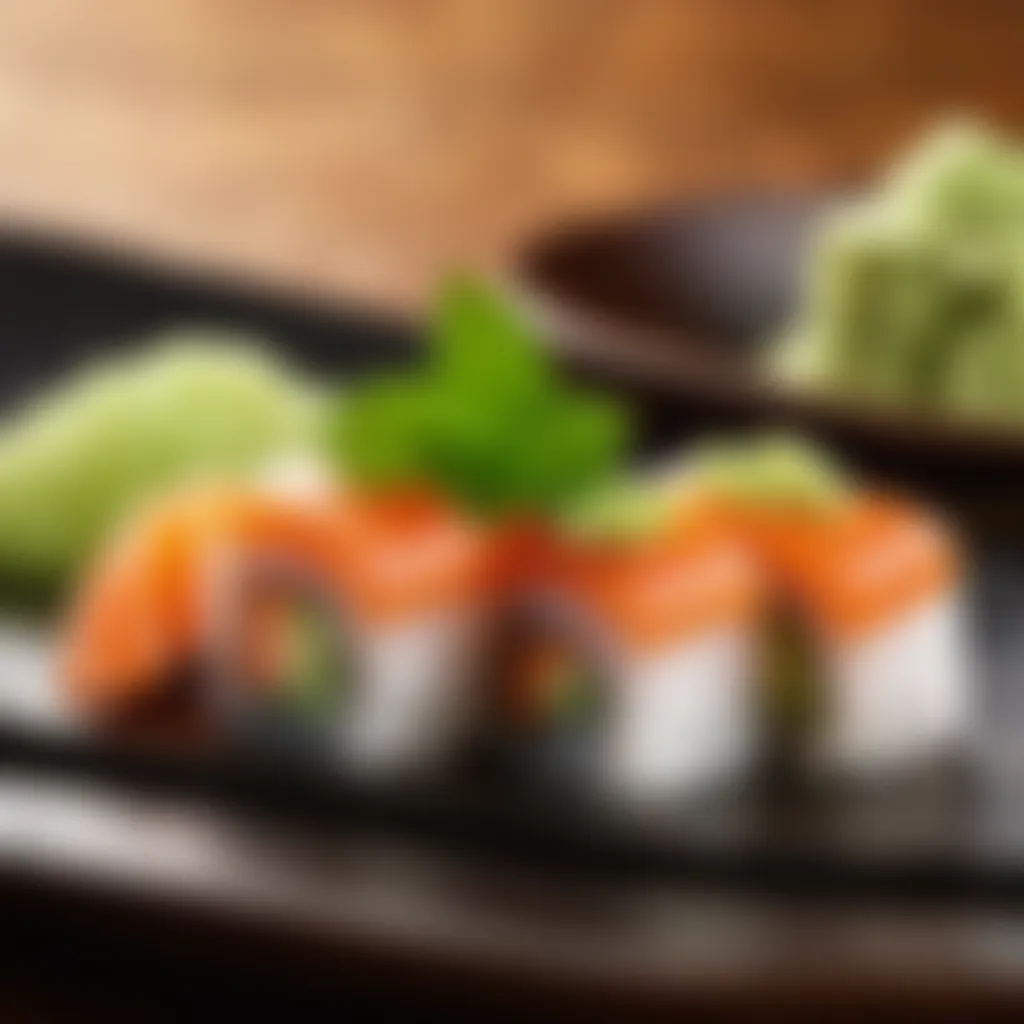

Food Safety Guidelines
To fully enjoy the nutritional benefits of salmon sushi, food safety cannot be overlooked. Raw fish can carry parasites and bacteria, making proper handling and preparation paramount. Here are some essential guidelines to keep in mind:
- Source Fresh, High-Quality Salmon: Ensure that the salmon is sourced from reputable suppliers. Look for fish that has been previously frozen, as this helps to kill potential parasites.
- Keep It Cold: Maintain proper refrigeration. Salmon should be kept at temperatures below 40°F to inhibit bacteria growth.
- Cleanliness is Key: Always sanitize surfaces and utensils that come into contact with raw salmon. This minimizes the risk of cross-contamination with cooked items.
- Use Safe Prep Techniques: Wash hands thoroughly before and after handling raw fish. Using separate cutting boards for veggies and fish can also prevent any contamination.
Following these guidelines is essential not only to enjoy sushi safely but to cultivate a love for this dish without the looming risk of foodborne illnesses. By prioritizing both nutritional value and safety practices, crafting salmon sushi becomes a delightful experience that can be enjoyed by all.
Innovative Variations of Salmon Sushi
Exploring innovative variations of salmon sushi adds a layer of creativity and flexibility to this beloved dish. Not only does it give you the chance to stray from traditional recipes, but it also allows you to cater to various tastes and dietary needs, making sushi an inclusive option for many. Moreover, by experimenting with new flavors and techniques, you can entice and surprise your family and friends, enhancing your gatherings or casual weeknight dinners.
When tossing in unique ingredients and methods, you'd be wise to consider balanced flavors and textures. A harmonious blend can elevate your sushi experience from good to outstanding. Consider the textures in your salmon sushi; crisp vegetables or crunchy toppings can complement the soft, tender fish, creating a pleasing contrast.
Furthermore, using seasonal and local ingredients not only supports sustainability but also brings new life to your sushi rolls.
Fusion Cuisine Examples
Fusion sushi incorporates elements from different culinary traditions, resulting in exciting and sometimes unexpected combinations. Think outside the box and you might find inspiration in your pantry or local marketplace.
- Spicy Tuna Roll with Jalapeño: Adding spicy tuna to your sushi roll may seem simple, but if you include thin slices of fresh jalapeño and a drizzle of wasabi mayo, it becomes a delightful kick.
- Pico de Gallo Sushi: This sushi roll marries together traditional Japanese with vibrant Mexican flavors. Instead of using the usual cucumber, try making a roll with pico de gallo for added zest and color to your dish.
- Italian Caprese Sushi: Think mozzarella, basil, and cherry tomatoes all rolled with sushi rice and nori. It gives a fresh take on sushi while highlighting the wonderful Mediterranean ingredients.
It can be fun to mix and match unexpected ingredients much like putting together a puzzle of tastes. Don't be afraid to embark on culinary adventures; after all, the kitchen should feel like a place for experimentation.
Seasonal Ingredients Modifications
Seasonal ingredients are not just for show; they can create a profoundly different dining experience. Sushi is all about freshness, and incorporating what’s most bountiful in your area can transform your rolls.
- Spring: Add thin slices of asparagus or spring peas to your rolls. Pair these with flaky salmon for a refreshing taste that captures the essence of the season.
- Summer: When the sun is shining, consider peaches or watermelon. These fruits can be sliced and rolled in sushi for a summery sweetness that balances the savory salmon.
- Fall: Butternut squash offers a hearty texture and taste in fall rolls. Finely diced, it can add a satisfying element to your sushi creations.
- Winter: As it gets cold, consider root vegetables such as carrots or sweet potatoes. Roasted carrots add both sweetness and warmth to your dish, pairing beautifully with the rich flavors of salmon.
By tailoring your sushi to the seasons, you elevate the experience of the meal, showcasing what nature provides at its best while promoting sustainability.
Any innovative variation you decide to try allows for personal expression in your cooking. Each experiment serves not only to enhance your appreciation of sushi but also to refine your skills in the kitchen. Ultimately, sushi-making is an art, and each roll tells a unique story of creativity and flavor.
End
Crafting salmon sushi is not just about assembling ingredients; it’s an intricate dance of flavors, textures, and artistry. Each step in this culinary journey contributes to the overall experience, making it essential to reflect on what one has learned along the way.
Reflecting on the Craft
When you take a moment to look back at your salmon sushi-making efforts, it’s clear that this isn't merely a meal; it's a labor of love. The simple act of preparing sushi can feel daunting at first, but with each attempt, a deeper appreciation for the craft emerges. Recognizing the care involved in filleting salmon or perfecting sushi rice brings a sense of mastery and pride. Every roll that’s been skillfully crafted adds not just to one’s culinary repertoire but also to a growing repertoire of memories shared over meals with family and friends.
Moreover, noting the importance of quality ingredients throughout your journey reinforces the connection to your food sources. The freshness of salmon, the texture of rice, and the balance of accompanying flavors come alive when one is truly mindful—a practice that transforms cooking into an art form rather than just a chore.
Embracing the Process
As you delve into sushi-making, embracing the process becomes paramount. The playful experimentation with various ingredients, flavors, and techniques encourages a creative spirit. Trying out seasonal variations or even daring fusion combinations allows you to personalize your sushi while fostering innovation in your kitchen.
This approach not only helps hone culinary skills, but it also means that preparing sushi can be a joyful endeavor rather than a rigid task. Being present in each step—whether rolling, glazing, or garnishing—adds an element of mindfulness to your cooking practice.
Ultimately, sushi is about sharing joy, creativity, and connection. Embrace the missteps; they are part of the learning curve. Every grain of rice and slice of salmon carries with it a story, a lesson waiting to unfold on your very own sushi adventure.







